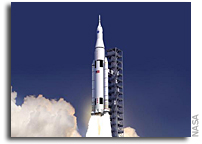Boeing Delta Cryogenic Stage for SLS

NASA/MSFC intends to purchase the labor and hardware necessary to meet requirements from The Boeing Company. To fulfill these requirements, Boeing will modify its existing Delta Cryogenic Second Stage (DCSS).
NASA Solicitation: Interim Cryogenic Propulsion Stage for the Space Launch System
Synopsis – May 03, 2012
General Information
Solicitation Number: SLS-SPIO-0001
Posted Date: May 03, 2012
FedBizOpps Posted Date: May 03, 2012
Recovery and Reinvestment Act Action: No
Original Response Date: May 18, 2012
Current Response Date: May 18, 2012
Classification Code: 18 — Space vehicles
NAICS Code: 336415
Contracting Office Address
NASA/George C. Marshall Space Flight Center, Procurement Office, Marshall Space Flight Center, AL 35812
Description
NASA/MSFC has a requirement for an Interim Cryogenic Propulsion Stage (ICPS) for the early Space Launch System (SLS) missions. The early flights of the SLS architecture will require the use of an ICPS to ensure the placement of the Orion Multi-Purpose Crew Vehicle (MPCV) and/or payload on the required trajectory. In order to support the flight schedule, the initial ICPS flight unit must be delivered to Kennedy Space Center (KSC) no later than late in the fourth quarter of the 2016 government fiscal year (GFY). The second flight unit must be delivered to KSC by the fourth quarter of the 2020 GFY. Design parameters/ performance characteristics for the ICPS are as follows:
1. Human Rated per NPR 8705.2B, Human-Rating for Space Systems (at a minimum the second flight unit will be human rated);
2. Burns (accelerating MPCV) following placement of ICPS and MPCV at 975 x -50 nmi insertion point by the SLS Launch Vehicle — three engine ignitions to achieve greater than 3050 m/s delta-V;
3. Lift Capability — total weight of 53404 lbs which includes crew module, service module, and crew;
4. Mass — less than 71400 lbs.;
5. Length — packaged, as stacked, within 500″;
6. Functional Capability — perform a separation event and have three-axis attitude control after SLS insertion and prior to separation from MPCV;
7. Constraints — axial acceleration, during stage burns, not to exceed 2g; and
8. Reference Missions — support MPCV free lunar return without crew and MPCV High Lunar Orbit (HLO) with crew.
NASA/MSFC intends to purchase the labor and hardware necessary to meet the requirements described above from The Boeing Company (Boeing). To fulfill these requirements, Boeing will modify its existing Delta Cryogenic Second Stage (DCSS). As a result of internal market research that looked at available in-space propulsion capabilities in the United States, Europe, and Japan, NASA determined that the DCSS, with minor modifications, was capable of fulfilling the SLS needs. This market research was validated by the results of a sources sought synopsis published on January 9, 2012. Based on the responses to that sources sought synopsis, NASA determined that the DCSS is the only means available to support the immediate in-space propulsion needs of the SLS within the SLS manifest schedule constraints. The DCSS is the only known in-space stage requiring relatively minor modifications to enable full compliance with the requirements of the early SLS manifest. As currently designed, the DCSS meets all requirements noted above except Human Rating and delta-V. It has the means to be human ratable, since with the minor modifications it can be human rated by the second flight unit. No other in-space propulsion stage (either existing with proven flight performance, or planned) requires such relatively minor modifications to be made fully compliant with the SLS requirements. Boeing maintains the data rights to the DCSS. Boeing maintains the unique and specific design and testing knowledge/skills required to affect the types of modifications to the DCSS necessary to enable full compliance with the requirements of the early SLS manifest.
The Government does not intend to acquire a commercial item using FAR Part 12.
All responsible sources may submit a capability statement, proposal, or quotation which shall be considered by the agency. Interested organizations may submit their capabilities and qualifications to perform the effort in writing to the identified point of contact not later than 4:30 p.m. Central time on May 18, 2012. Such submissions concerning capabilities/qualifications will be evaluated solely for the purpose of determining whether or not to conduct this procurement on a competitive basis. A determination by the Government not to compete this proposed effort on a full and open competition basis, based upon responses to this notice, is within the discretion of the Government.
Oral communications are not acceptable in response to this notice.
NASA Clause 1852.215-84, Ombudsman, is applicable. The installation Ombudsman is Ms. Robin N. Henderson, (256) 544-1919 or robin.n.henderson@nasa.gov.
Point of Contact
Name: Jane L Thomas
Title: Contract Specialist
Phone: 256-544-7893
Fax: 256-544-3223
Email: Jane.L.Thomas@nasa.gov
Name: Hervie B. Williford
Title: Contracting Officer
Phone: 256-544-0373
Fax: 256-544-6062
Email: hervie.b.williford@nasa.gov








